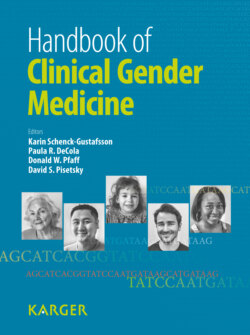Читать книгу Handbook of Clinical Gender Medicine - Группа авторов - Страница 61
На сайте Литреса книга снята с продажи.
Reproductive Ducts Mesonephric and Paramesonephric Ducts
ОглавлениеMale differentiation of the mesonephric duct occurs in response to testosterone secreted locally by the ipsilateral testis. At the 7th week, developments are seen to diverge between the sexes. Sequential expression of many genes during formation of the epididymis, vas deferens, and seminal vesicle is involved. Secretion of the glycoprotein MIS by Sertoli cells leads to regression of the Müllerian ducts. Incomplete regression occurs in some types of DSD, leading to vaginal remnants or utricular cysts. In the female fetus, organogenesis involves regression of the mesonephric ducts as well as stabilization of the paramesonephric ducts. This proceeds in the absence of testicular hormones. At the time of apparent male differentiation in an XY fetus, the comparable undifferentiated structures in the female are irreversibly committed to female organogenesis. At the end of the embryonic period, fusion of the caudal ends of the two paramesonephric ducts with the urorectal septum occurs, forming the uterus (at about 63 days of gestation). The cephalic ends develop fimbriae, the lower segment, and the uterine tube, with transverse lie established by descent of the ovary. The genital canal is established at about 80 days with absorption of the median septum. It lengthens, and its caudal end continues to grow and contacts the posterior wall of the urogenital sinus. With additional cellular proliferation, the vagina is formed. The cervix (caudal two thirds of the fetal uterus) may be of either paramesonephric or urogenital sinus origin [2]. The uterus and vagina can be visualized by ultrasound, and the cervix can be seen by genitoscopy postnatally. In the case of a girl with an inguinal hernia containing an ovary, genitoscopy has been suggested to rule out androgen insensivity syndromes.
